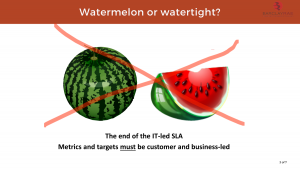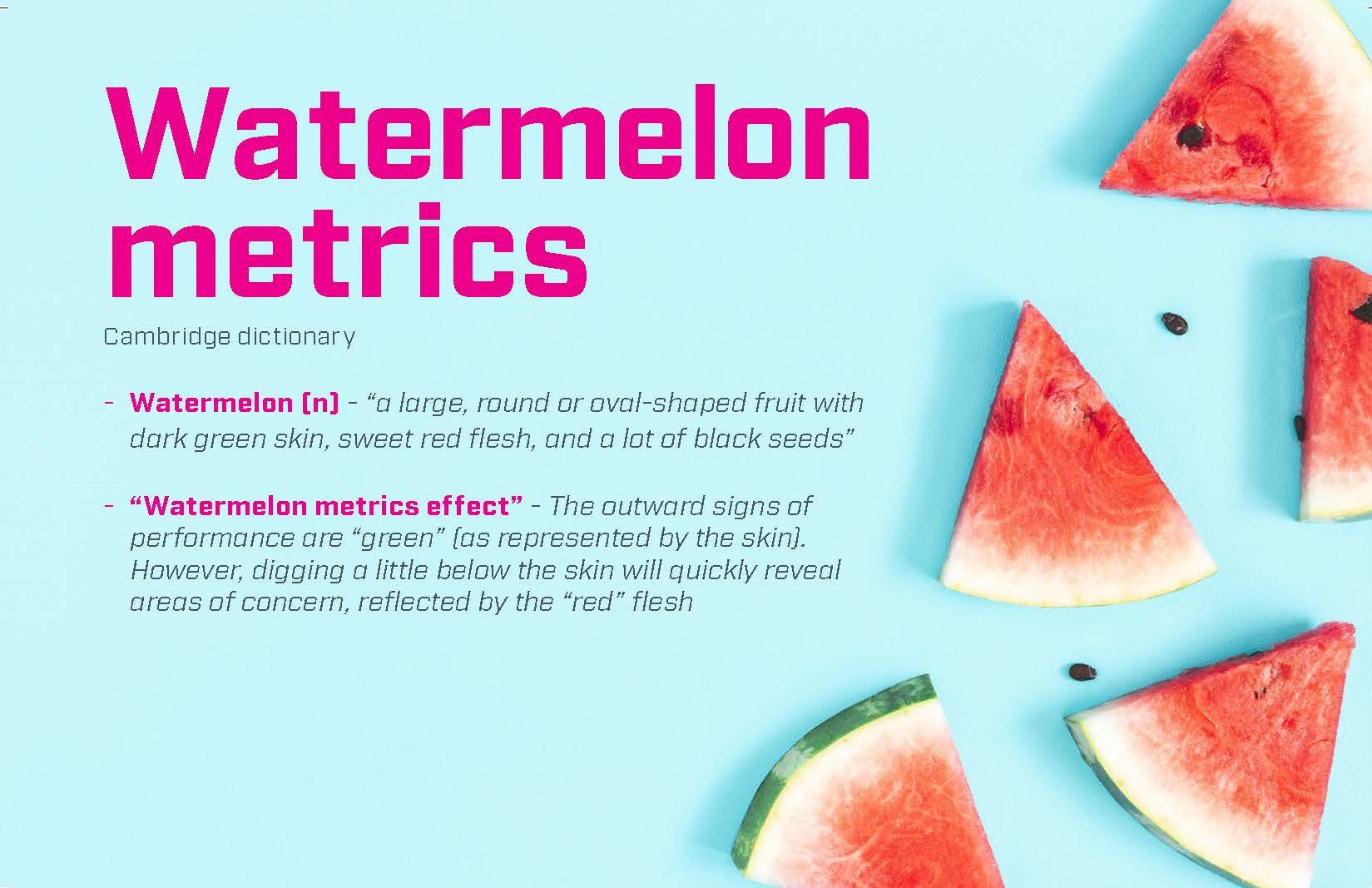The ‘Watermelon SLA’ concept is a simple graphical way of showing that many SLAs are not fit for purpose. This has been successful in getting some clear and honest messages across to the industry about expectation management, performance measurement, metrics and relationship management.
The basic idea of this is that, as a watermelon looks green from the outside, but is in fact a red fruit inside, IT metrics and contracted agreements can be met and look ‘green’ on a RAG report, when the reality for the business user is of a failed ‘red’ experience and outcome. The reasons behind this are mostly around a lack of agreement on the actual business outcomes required from the service, or how it feels when the service is consumed by its users. SLAs are often driven and defined entirely by IT people without collaboration or agreement, and as such they are only concerned with measuring individual IT components, rather than the cumulative sum effect of these as they are used.
I’ve written on this on a number of occasions. It’s one of these ideas that is so simple to show and communicate via a picture, rather than an explanation. I have used this for over 10 years and initially thought that I’d created the idea myself, although I know a few others came up with the same concept around the same time. It doesn’t matter who came up with this of course – what is important is the recognition that the image and concept can create. This has been quite successful in communicating an idea although many organisations still have been working to outdated old watermelon SLAs…
The Covid pandemic has of course changed a lot of expectations and actual delivery levels for much of the standard IT services package. Traditional models have been set aside in the rush to establish new ways of working. Service desks and support teams have new demands and customer expectations. My hope and belief is that all of this will finally help us to move away from the watermelons, to a much more ‘watertight’ approach that is inclusive, integrated and honest – i.e. it reflects business reality, not IT focus. Covid has been the catalyst to sweep away the IT-led watermelon SLA – at last.

As we move into the new worlds of digital and agile and post-covid IT, there are now a variety of new ways of thinking about the ‘SLA’ concept. These must reflect the need for more than just individual metrics relating to individual service components. We now understand the end-to-end requirements of value streams and how services include a number of components, resources, skills and practices. Agreements and associated metrics must relate to the intended business outcomes required – and whether these have been met or not, regardless of the individual components.
OXMs – Outcome- and eXperience-based Metrics
XLAs – Experience level agreements – have grown in popularity in recent times and in ITIl4 and other frameworks and models. The idea here is a good one in that the measurement of success is based on customer and user experience measurement overall, regardless of individual IT performance. There is a need to also include business outcomes, employee experience and also performance measurement in this as part of a metrics ‘bundle’ – so this could include individual service metrics, business key metrics and feedback as well as customer data. These can then be weighted to provide single overall metrics that reflect both experience and outcomes.
Discussions around ‘agreements’ can then simply focus on the relative importance of the individual metrics – so the OXM is a hybrid of customer/user, business and IT performance and value. This can be developed as an extension of what we have previously referred to as services and service catalogue – with added outcomes and definitions of overall value and success.
The Watermelon meme should therefore be replaced with the idea of a watertight and well managed ship – containing a number of different elements, people, skills and resources – that is headed in a single direction. Our metrics and measures should then reflect progress on the journey, safety, fuel efficiency etc.
The OXM will therefore show progress on reaching the destination safely, on time and profitably, not simply that the food was good but we sank…
So, how is your organisation doing with Outcome and Experience based measurement? Are you enjoying the food and entertainment, but sinking?
If you need help in defining OXMs, service catalogues, customer journey maps, value streams, or even ‘good’ SLAs, please contact us or read our recent blog on how the concept of Service Integration And Management (SIAM) could help with solving this….



